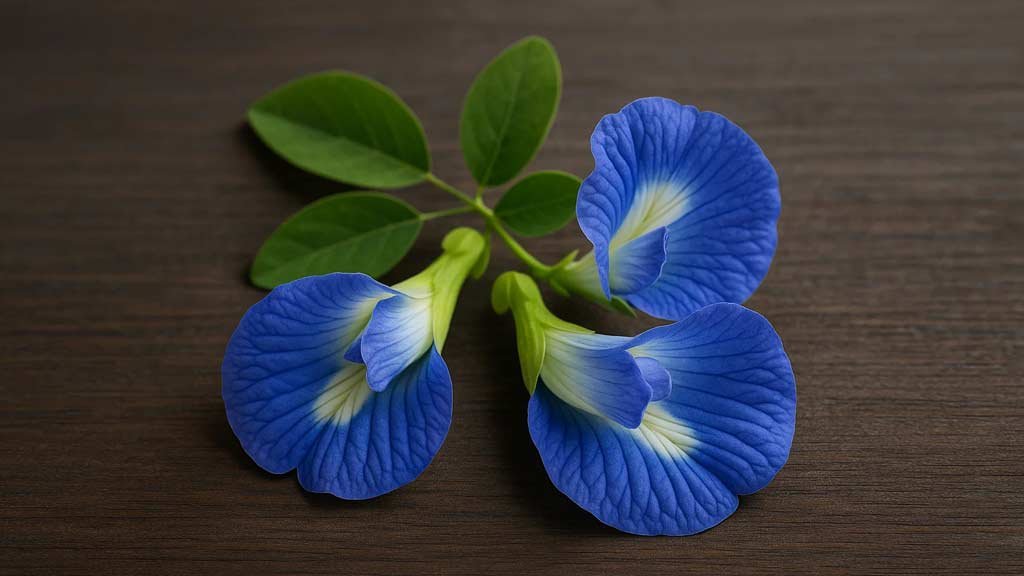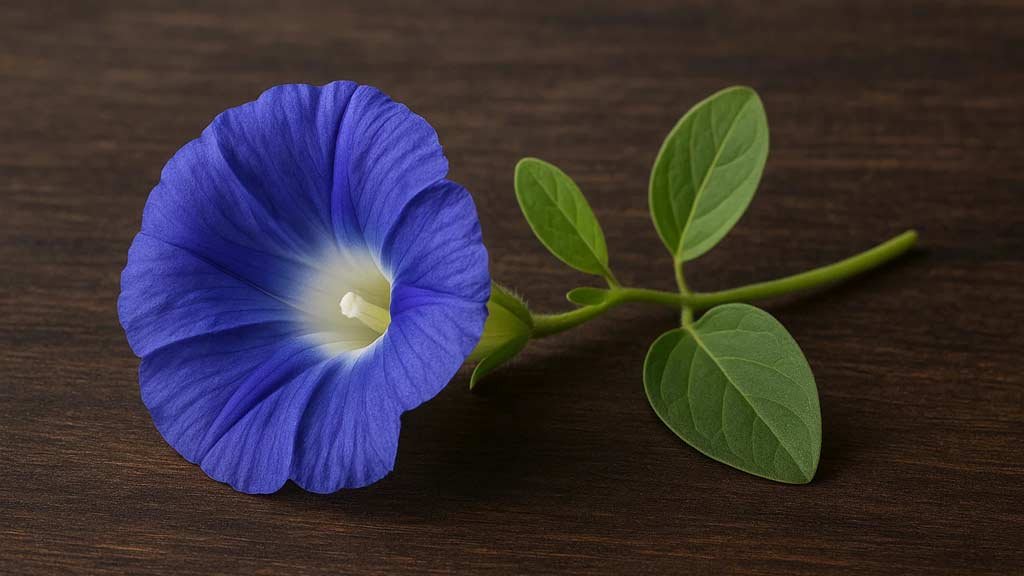What Is Shankhpushpi?
Shankhpushpi (Convolvulus pluricaulis) is a creeping plant with delicate white or light-blue flowers, widely respected in Ayurveda as a “medhya rasayana,” meaning a rejuvenator for the brain and nervous system. The name itself comes from its flower shape—like a conch shell (shankh in Sanskrit).
In traditional medicine, it’s been given to students before exams, elders struggling with forgetfulness, and anyone under constant mental strain. It’s not just one of those herbs you throw in a tea for flavor—it has a clear role: sharpening memory, calming restless nerves, and supporting longevity of the mind.
Table of Contents
The Traditional Role of Shankhpushpi in Ayurveda
Ayurvedic texts mention Shankhpushpi as a tonic for both the mind and body. It’s considered cooling, slightly bitter, and grounding in nature. Practitioners often prescribe it for imbalances of Vata and Pitta, which are linked with nervous tension, scattered thoughts, and irritability.
Some of the classic uses in Ayurveda include:
- Enhancing memory retention and recall
- Reducing stress and anxiety
- Supporting restful sleep
- Improving digestion when stress is the trigger
- Calming heart palpitations
There’s a saying in Ayurveda that “a calm mind digests well,” and Shankhpushpi often shows up in formulas meant to calm both stomach and spirit.
How Shankhpushpi Affects the Nervous System
If you’ve ever experienced racing thoughts at midnight, or the way your hands tremble before a big presentation, you know what a strained nervous system feels like. Shankhpushpi works gently here.
Its compounds—alkaloids, flavonoids, and glycosides—are thought to act on the central nervous system. Preliminary studies suggest it may modulate neurotransmitters like serotonin and GABA, which are tied to mood regulation and calm focus.
In plain terms: it doesn’t knock you out, but it takes the edge off. Think of it as a herb that whispers to your nervous system, reminding it to soften.
A Calming Yet Awakening Effect
What makes Shankhpushpi stand out is this balancing act: it relaxes the nerves while sharpening mental clarity. Many nervine herbs lean toward drowsiness, but Shankhpushpi doesn’t dull the mind. Instead, it creates the kind of calm where focus naturally flows.
Shankhpushpi and Memory
Memory is complicated. It’s not just about stuffing facts into your brain; it’s about recall, association, emotional tone, even smell. Ayurveda sees memory as something nourished by ojas—the vital essence that supports longevity and resilience. Shankhpushpi is said to strengthen ojas by feeding and cooling the brain tissue.
Some small clinical trials in India have reported improved memory performance in children and young adults taking Shankhpushpi extracts. Animal studies also point to neuroprotective effects, suggesting it may reduce oxidative stress in brain cells.
It’s no magic pill. But when combined with good sleep, proper diet, and meditation, it can be that extra layer of support your brain craves.
Other Health Benefits Linked to Shankhpushpi
Though most people think of Shankhpushpi strictly as a brain herb, Ayurveda casts a wider net.
- Stress and Anxiety Relief: Acts as a mild adaptogen, helping the body adjust to stress.
- Sleep Support: Encourages deeper, more restful sleep without heavy sedation.
- Digestive Aid: Calms stress-induced indigestion and acidity.
- Heart Health: Sometimes used to ease palpitations linked to anxiety.
- Skin Support: Traditional texts note its cooling property may soothe inflammatory skin issues.
It’s one of those herbs that reveals its layers over time. You might start taking it for memory, but notice your digestion or sleep shift along the way.
Forms of Shankhpushpi You Can Find
If you walk into an Ayurvedic shop, you’ll likely see Shankhpushpi in several forms:
- Powder (Churna): Commonly mixed with warm milk or ghee.
- Syrup: Popular in India, often given to children for concentration.
- Capsules/Tablets: A modern, convenient option.
- Herbal Blends: Frequently paired with Brahmi, Ashwagandha, or Jatamansi.
I’ve tried it as a powder, and while the taste isn’t exactly delightful—bitter, earthy, a bit musty—the calm focus that follows makes it worthwhile. If taste is an issue, the capsules are an easy compromise.
How to Use Shankhpushpi Safely
No herb is a cure-all, and Shankhpushpi is no exception. Dosage and form matter.
- Powder: 1–3 grams daily, often with warm milk.
- Syrup: 10–15 ml, once or twice a day.
- Capsules: Typically 300–500 mg per serving, depending on the product.
Safety notes:
- Generally considered safe in moderate doses.
- Pregnant and breastfeeding women should avoid it unless guided by a qualified practitioner.
- Those on sedatives or antidepressants should consult their doctor, as there could be interactions.
Ayurveda emphasizes personalization. One person might thrive on a teaspoon of powder daily; another may find half that amount enough.
Shankhpushpi Compared to Other Brain Herbs
If you’re familiar with Ayurvedic brain tonics, you’ve probably heard of Brahmi (Bacopa monnieri). People often confuse Brahmi and Shankhpushpi, but they’re not the same.
- Brahmi is strongly memory-enhancing, with a stimulating edge.
- Shankhpushpi is more about calm clarity—like clearing mental fog without overstimulation.
Then there’s Ashwagandha, which is grounding and reduces stress but doesn’t directly sharpen memory.
Shankhpushpi sits somewhere in the middle, making it a gentler, more balanced choice.
Anecdotal Notes and Real-World Use
I once spoke to an Ayurvedic doctor in Varanasi who laughed when I asked which herb he gives anxious students. “Always Shankhpushpi,” he said, “otherwise they don’t sleep and then forget everything.” His clinic had a line of teenagers during exam season, all clutching little bottles of syrup.
Another friend swore by Shankhpushpi powder during her yoga teacher training. “It kept me calm during the written tests,” she told me, “but I didn’t feel heavy-headed like with valerian.”
These are just stories, but they mirror the traditional wisdom: a herb for calm confidence.
Modern Research on Shankhpushpi
While not as extensively studied as ginkgo or bacopa, Shankhpushpi has been the subject of growing research:
- Neuroprotection: Animal studies show reduced oxidative damage in brain tissue.
- Memory Enhancement: Small human trials indicate improved learning and recall.
- Anxiolytic Effects: Evidence suggests it lowers markers of stress in lab animals.
- Anticonvulsant Activity: Some studies indicate it may help regulate seizures.
The challenge is scale—most studies are small, and not all use standardized extracts. But the pattern is consistent with what Ayurveda has known for centuries.

Growing and Identifying Shankhpushpi
For gardeners, Shankhpushpi is a creeping perennial with slender stems and small conch-shaped flowers. It thrives in warm climates and sandy soil. Collecting it fresh for medicine requires real skill, though, because it’s often confused with other species that share the name “Shankhpushpi” in regional traditions.
The true Convolvulus pluricaulis is the one most referenced in Ayurvedic texts. Some traditions also use Evolvulus alsinoides, and while similar, they’re not identical.
Practical Tips for Incorporating Shankhpushpi
- Take it in the morning for clear focus during the day.
- Pair it with Brahmi if memory is the main concern.
- Pair it with Ashwagandha if stress and sleep are bigger issues.
- Avoid taking it right before meals if you’re using the powder—its bitter edge can dull appetite.
And remember, herbs don’t work in a vacuum. A balanced diet, regular sleep, and mindfulness practices multiply the effects.
Final Thoughts
Shankhpushpi isn’t flashy. It doesn’t promise overnight brilliance or superhuman memory. Instead, it offers something subtler: steadiness, clarity, and the kind of calm that allows the mind to work at its best.
In a world wired for overstimulation, where attention is constantly fractured, maybe this humble creeping herb from the Ayurvedic tradition is exactly what we need.
Article Sources
At AncientHerbsWisdom, our content relies on reputable sources, including peer-reviewed studies, to substantiate the information presented in our articles. Our primary objective is to ensure our content is thoroughly fact-checked, maintaining a commitment to accuracy, reliability, and trustworthiness.
- Bafna, P. A., & Mishra, S. H. (2005). Antioxidant and immunomodulatory activity of the alkaloidal fraction of Convolvulus pluricaulis Choisy. Phytomedicine, 12(5), 407–415. https://doi.org/10.1016/j.phymed.2003.12.010
- Bihaqi, S. W., Singh, A. P., Tiwari, M., & Khanam, R. (2009). Supplementation of Convolvulus pluricaulis attenuates scopolamine-induced increased oxidative stress and reduces memory impairment in rats. Contraception, Fertility and Sexology, 37(3–4), 167–175. https://doi.org/10.1016/j.jep.2008.09.042
- Indian Journal of Pharmacology. (2010). Effect of Convolvulus pluricaulis on learning behavior and memory enhancement activity in mice. Indian Journal of Pharmacology, 42(6), 329–332. https://www.ncbi.nlm.nih.gov/pmc/articles/PMC2991700/
- Kaur, T., Pathak, C. M., Pandhi, P., & Khanduja, K. L. (2002). Effects of Convolvulus pluricaulis on learning and memory in rodents. Journal of Ethnopharmacology, 81(3), 297–301. https://doi.org/10.1016/S0378-8741(02)00122-0
- National Center for Biotechnology Information (NCBI). (2021). Convolvulus pluricaulis Choisy (Shankhpushpi): A traditional herb with potential cognitive benefits. PubMed. https://pubmed.ncbi.nlm.nih.gov/
- Sharma, A., Bhatia, S., & Kharya, M. D. (2010). Pharmacological basis for use of Convolvulus pluricaulis in memory dysfunction. Ayurveda Research and Practice Journal, 4(2), 91–99. https://www.researchgate.net/publication/280310829
- World Health Organization (WHO). (1999). WHO monographs on selected medicinal plants – Volume 1. Geneva: World Health Organization. https://apps.who.int/iris/handle/10665/42052

